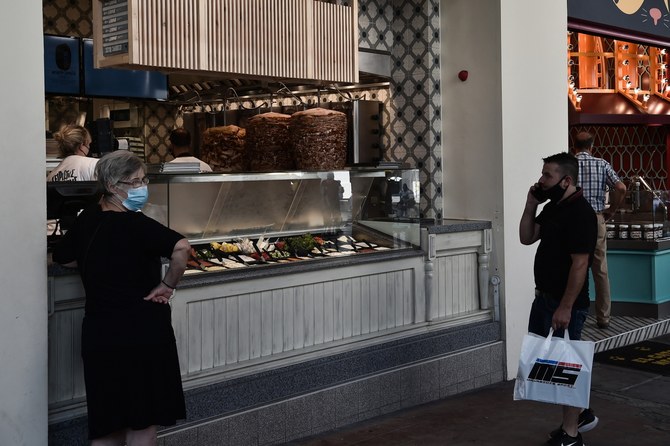
With half the world ablaze, from Gaza to Donetsk and Syria to Sudan, it is heartening to note that our friends in Europe have their priorities in the correct order: and at the top of that order is food.
In Germany, a popular and uniquely Teutonic campaign is underway for a cap on the price of a doner kebab, which had remained at about €4 ($4.30) for years but doubled after the coronavirus pandemic and is now approaching €10. Across the border in France, the country’s legions of traditional artisan pâtissiers are up in arms over a trend among young bakers to create giant croissants, pains au chocolat and pains aux raisins, some weighing up to 1 kg — partly for consumption by particularly peckish breakfasters, but mainly in a contest for fans on Instagram and TikTok.
Both comestibles, of course, have their roots in this part of the world. The doner kebab has Turkish origins, but what is it other than a poor man’s shawarma? Arabs have been eating meat grilled on skewers for centuries and even exported it to Mexico in the form of tacos al pastor. The Germans, meanwhile, can thank Turkish migrant workers who arrived after the Second World War and brought with them the vertical rotisserie, invented during the Ottoman era and with which we are now all so familiar.
It would be fair to say that, elsewhere in Europe, the doner kebab has a less than salubrious reputation. In England’s cities in particular, carousers who have supped not wisely but too well queue up in late-night kebab shops to purchase meat of indeterminate origin stuffed into recycled cardboard masquerading as pita bread, which they eat while walking home — and then wonder why they feel unwell in the morning.
With the price of a doner kebab, the Left Party has identified a bandwagon and has wasted no time in jumping aboard
Ross Anderson
In Germany, however, the doner is entirely respectable, a lunchtime staple for office and shop workers on benches in city parks. Germans being Germans, they have even created a compound noun for the price campaign — “Donerpreisbremse,” or “doner price brake.”
And while Germany did not become Europe’s free-market economic powerhouse by imposing artificial price caps on goods and services, nor are its politicians blind to an opportunity when it presents itself. In this case, the Left Party has identified a bandwagon and has wasted no time in jumping aboard. The party has demanded that the price of a doner be capped at €4.90 and €2.50 for school pupils, with the gap between the subsidized price and the real one funded by the taxpayer. “This isn’t an internet joke, but a serious call for help,” the party’s spokesman said. “The state must intervene so that food does not become a luxury.”
As to the origin of the croissant, that depends on which legend you choose to believe. One is that Europeans created it to mark the defeat of the Umayyad army by the Franks at the Battle of Tours in 732, its shape emulating that of the Islamic crescent; another is that all-night bakers alerted Christian forces to Ottoman tunnelling, thus ending the Siege of Vienna in 1683, and that their crescent-shaped baked goods referred to the emblems on the Ottoman flags. Both accounts are almost certainly fictional, but let us not permit the facts to get in the way of a good myth.
Unlike in Germany, the culinary argument in France is less economic than cultural. It was started by chef Philippe Conticini, whose 1 kg croissants — compared with the usual weight of about 80 g — are flying off the shelves of his Paris bakery, even at an eye-watering €32 each. Others have joined in. One baker in Paris offers “le big pain aux raisins,” 350 g for €9.90; another in Toulouse has “la chocolatine XXL” at €12; and, in a sign that the trend has gone mainstream, the Paris department store Galeries Lafayette is knocking out “le big pain au chocolat” at €14.90 for 320 g.
France’s politicians have not yet chosen sides in the war of the giant croissants, but it can only be a matter of time
Ross Anderson
Conticini’s marketing director (of course he has a marketing director, what do you think this is all about?) defends the quality of the giant product. “It’s now become a diktat that you have to create an event for Instagram or TikTok. Alas, that often takes precedence over taste,” he admitted. “But we are here above all to procure emotions by tasting.”
Others are unimpressed. One traditional pâtissier in Alsace complained: “Some of the new generation pastry chefs and bakers come up with creations with the foremost obsession being the impact of novelty in social media.”
So far, again unlike in Germany, France’s politicians have not yet chosen sides in the war of the giant croissants, but it can only be a matter of time. Few subjects capture the French imagination more comprehensively than gastronomy, which makes it a political matter. Charles de Gaulle once questioned how it was possible to govern a country that had 246 different kinds of cheese, and that was before they started putting truffle in the Brie.
And being on the wrong side of the argument can have fatal consequences. When it was pointed out to Marie Antoinette, queen of France during the French Revolution, that her subjects were too poor to buy bread, she is said to have responded: “Qu’ils mangent de la brioche.” OK, it’s not quite “Let them eat cake,” the tone-deaf phrase for which she is best remembered. And the quote is almost certainly as much of a myth as the origins of the croissant — but they had the poor woman’s head off for it anyway.
Ross Anderson is associate editor of Arab News.












